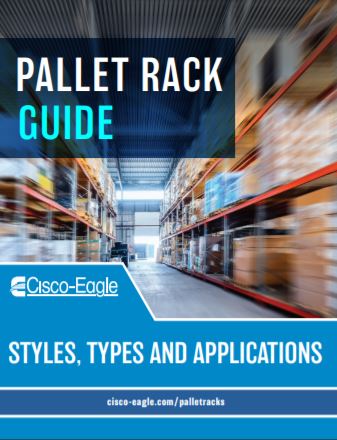Evaluation: Pallet Rack Storage Density, Access, Safety and Costs
What matters, why and when
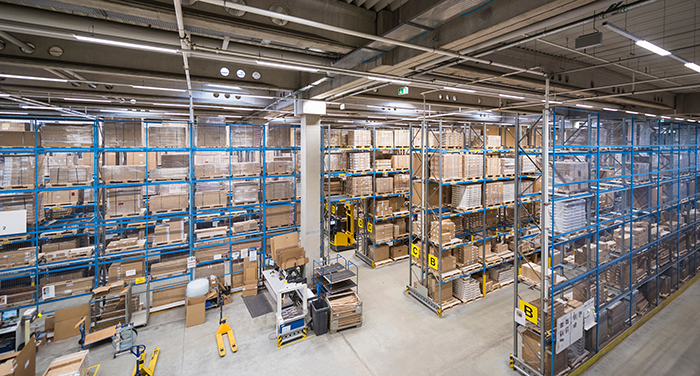
Just how many pallets can you store in a 100′ x 100′ area? It can range from not that many–X with selective racks that let you pick or place any pallet at any time–or “Y” using incredibly dense, using pallet flow or drive-in systems that restrict how and when you can access pallets. The balance between storage density and selectivity is always critical, but there are other factors in play: cost, efficiency and safety.
- If storage density was always the goal, that decision would be easy.
- The choice is also easy if selectivity is always the goal.
- If the choice hinges on efficiency, what are those factors, and how do you define them?
- How are you evaluating safety in this process?
- What about cost? Certain systems work better than others, but have higher initial and ongoing costs.
The factors
How these scores were calculated
Note: Estimates assume rack systems of 3 beam levels in a standard warehouse and 12′ aisles. These ratings and the assumptions they are based on will vary based on facility, load and operational factors.
Pallets Density (1 = excellent, 5=poor)
This assumes standard layouts, pallet sizes/weights, and ability to reasonably utilize the space. Factors like ceiling height, building column placement, traffic flow and others impact these ratings.
Selectivity (1 = excellent, 5=poor)
How easy is it to pick or place a given pallet?
Efficiency (1= high efficiency, 5=low efficiency)
Efficiency is difficult to rate across multiple storage and access methods. For instance, a selective system lets you pick or place from or to any position at any point in time. However, that requires forklifts or AGVs moving from place to place. In the highest density instance–deep pallet flow–you may not need that selectivity, and efficiency is based on fast access to first-in, first-out inventory. Generally, the fewer forklifts needed, with the least cumbersome traffic pathways, the more efficient storage is. But this is highly dependent on your goals.
Relative cost ($=most economical, $$$$$=least economical)
Higher density systems are significantly more expensive than selective ones. This is relative cost, meaning that other costs (space, transit time, environment) tend to offset those costs in the right application.
Safety (1 = excellent, 5=poor)
When correctly specified, loaded and used, all pallet rack is very safe. Since it holds heavy, elevated weights, must be loaded by, and interacts with people, safety is a critical discussion.
| Rack Type | Pallet Density | Selectivity | Efficiency | Relative Cost | Safety |
|---|---|---|---|---|---|
| Selective | 5 | 1 | 2 | Low $ | 3 |
| Double-Deep | 4 | 2 | 2 | Moderate $$ | 3 |
| Pushback (2-Deep) | 3 | 3 | 3 | Moderate $$ | 1 |
| Pushback (4-Deep) | 2 | 4 | 3 | High $$$ | 1 |
| Pallet Flow (6-Deep) | 2 | 4 | 2 | High $$$ | 1 |
| Pallet Flow (10-Deep) | 1 | 5 | 3 | Very high $$$$ | 1 |
| Drive-In (4-Deep) | 2 | 5 | 3 | High $$$ | 2 |
| Drive-In (10-Deep) | 1 | 5 | 4 | High $$$ | 2 |
Note: these ratings and the assumptions they are based on can and will vary based on facility, load and operational factors. They are generally in line with design standards, but will change as various factors shift.
Selective pallet racks: the default standard for most applications
Use case: best for high SKU count and fast picking
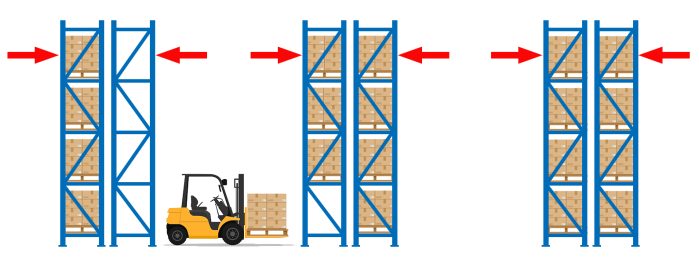
- Storage Density, Poor (5): Each pallet requires dedicated aisle space, which is typically 12′ for standard forklifts. Note that pallet racks are rated vs. other rack storage density. Selective racks offer excellent density vs. stacked floor storage.
- Selectivity, Very high (1): You can pick or place any pallet at any time.
- Efficiency, (2-3): Selective racks are efficient for standard warehouse storage and varied SKU access, but require constant forklift movement between storage positions and destinations. This causes more wait, transit and dwell time for pallet access and delivery. If paired with driverless forklifts or AGVs, their efficiency ratings improve.
- Relative Cost: $. Selective and double deep systems are the lowest cost option in total and per pallet position costs.
- Safety: Usually safe (3) due to open layout and visibility. Selective racks require aisles and forklifts, which make them more subject to collisions and damage than most of the high-density systems. However, safeguards such as push-through protection, rack netting, rails and column protectors enhance safety.
Double deep systems are a form of selective rack that stores two pallets deep of identical SKUs in each storage position. This offers better storage density than selective but with lower selectivity and pallet access at similar safety ratings and higher costs. This type of storage offers good selectivity and improved density vs. selective racking systems.
Estimate your space and storage capacity with our selective pallet rack estimator
Pushback racks: a bridge between selective racks and deeper lane systems
Use case: single SKUs in each pallet lane
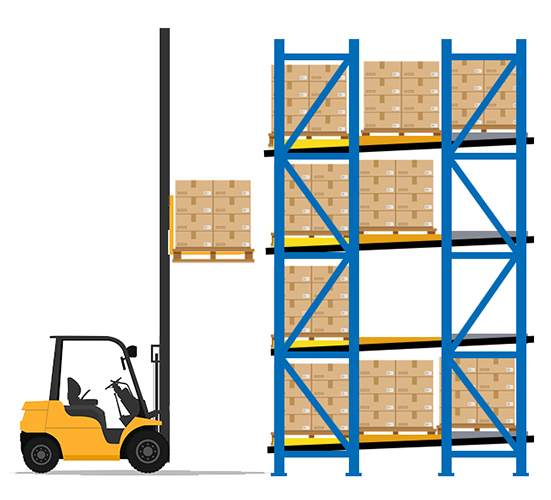
- Storage Density, Good (2-3): A compromise between access ease and density. Angled tracks reduce vertical utilization in some situations.
- Selectivity, Moderate (2-3) depending on pallet depth. Limited access to back pallets in a LIFO storage system. You can access a single SKU for each bay.
- Efficiency: Good (3): Pushback thrives in batching and similar operations. Drivers interact exclusively with front pallet positions to load and pick, which takes less time than drive-in systems. LIFO systems require more extensive space and access planning. Fewer forklifts are typically needed vs. selective systems.
- Cost, $$ to $$$: Pushback carts add to costs and have ongoing maintenance requirements. They’re costlier than selective systems, but relatively less expensive than other higher density options.
- Safety, Very safe (1): Carts can jam, which can be a safety issue if handled incorrectly. Pushback systems require the fewest lift trucks and least interaction with the rack structure and minimize interactions with the rack structure.
Pallet flow racks: highest density
Use case: first-in, first-out inventory rotation; ideal for perishables or high-volume SKUs
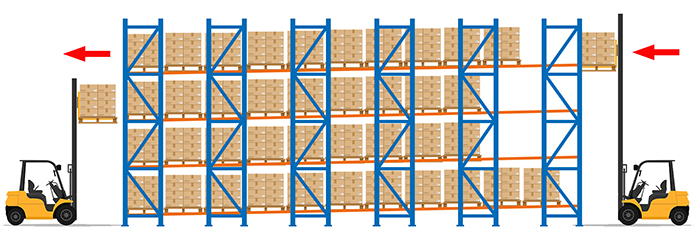
Above: gravity-fed rollers move pallets forward. Ideal for perishables or high-volume SKUs.
- Storage Density, very high (1-2): Pallet flow is usually the highest possible storage density pallet rack option.
- Selectivity, Low (4-5): Access only from two ends (load/unload). Each lane on each level lets you access a single SKU.
- Efficiency, High (2-3): Very fast picking on unload side is mirrored by fast loading on the loading side. This reduces driver and transit times and the costs associated with aisle and row navigation.
- Cost, $$$ to $$$$: Roller and brake systems must be engineered for specific loads, and subsequently maintained. These systems tend to be costly due to their dynamic elements
- Safety, excellent (1): Safety stops are critical when heavy pallets travel front to back and can pose a safety hazard. Forklift access and traffic tends to be lower for pallet flow system, as pallets are accessed and stored from only one side.
Drive-in rack systems
Use case: extremely dense system for storing large quantities of the same SKU
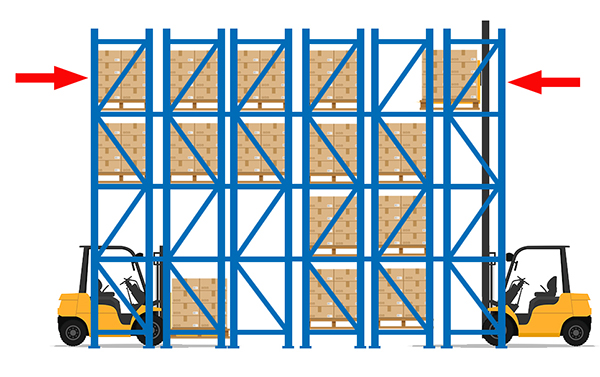
- Storage Density, Very high (1-2, depending on storage depth): Drive-in rack is often the highest possible storage density pallet rack option.
- Selectivity, Low (4-5): Each bay on each level lets you access a single SKU in a last-in, first-out configuration. This means you must be willing to store bulk, non-perishable items that requires little inventory rotation.
- Efficiency, Moderate (3-4): Access is slower than pushback, pallet flow or selective options since rack entry slows the process. This makes the focus of a drive-in system mostly on pallet density.
- Cost, Moderate to high $$$: Roller and brake systems must be engineered for specific loads, and subsequently maintained.
- Safety: Safe (2): Rollers need safety stops are critical when heavy pallets travel front to back. This requires design, maintenance and training.
Download our Pallet Rack Guide
Pallet rack enhances your warehouse and improves overall facility performance when correctly specified, laid out and installed for the right load in the right positions. Check out our guide to specifications, styles, accessories and applications with expert tips from our employee-owners.
You’ll find quick, useful information on racks and how you can use them more effectively.
Download the guide today
Tags: Space Optimization
Scott Stone is Cisco-Eagle's Vice President of Marketing with 35 years of experience in material handling, warehousing and industrial operations. His work is published in multiple industry journals an websites on a variety of warehousing topics. He writes about automation, warehousing, safety, manufacturing and other areas of concern for industrial operations and those who operate them.




